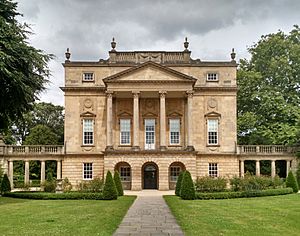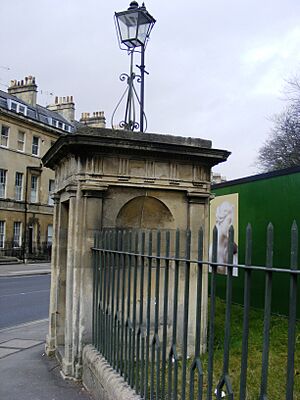Holburne Museum facts for kids

Front facade of Holburne Museum
|
|
| Lua error in Module:Location_map at line 420: attempt to index field 'wikibase' (a nil value). | |
| Established | 1882 |
|---|---|
| Location | Bath, Somerset |
|
Listed Building – Grade I
|
|
| Official name | The Holburne Museum |
| Designated | 12 June 1950 |
| Reference no. | 1395305 |
The Holburne Museum is a fantastic art gallery in Bath, England. It's found in the beautiful Sydney Pleasure Gardens. This museum was Bath's very first public art gallery. It's a special building, protected as a Grade I listed building.
Inside, you'll discover amazing fine and decorative arts. These artworks were collected by a man named Sir William Holburne. You can see paintings by famous artists like Gainsborough and Stubbs. The museum also hosts exciting temporary exhibitions, music, workshops, and family events. There's even a bookshop and a cafe with views of Sydney Gardens. The museum was updated and expanded in 2011.
Contents
Discovering the Holburne Collection
The main part of the museum's collection comes from Sir Thomas William Holburne (1793–1874). He was a second son and first worked in the navy. Later, he inherited his family's special title, called a baronetcy, in 1820.
Sir William loved collecting all sorts of interesting things. He added to his family's collection of Chinese porcelain, silver, and portraits. He gathered beautiful silver and porcelain from the 1600s and 1700s. You can also see Italian maiolica (a type of pottery) and bronze sculptures. His collection includes Old Master paintings, tiny portrait miniatures, books, and furniture. He also collected smaller items like Roman glass, coins, enamels, and snuff boxes.
In 1882, Sir William's sister, Mary Anne Barbara Holburne, gave his collection to the people of Bath. It included over 4,000 objects, pictures, and books! Since the museum opened, it has grown even more. Over 2,500 new items have been added.
Growing the Art Collection
Some parts of the original collection, like maiolica and silver, were already very complete. So, not much was added to those. But other areas, like glass, were much smaller. The glass collection grew a lot in the 1920s and 1930s. This happened thanks to gifts from the Blathwayt family and the Holburne Society.
The museum also expanded its collection of Asian ceramics. Earlier pieces were given by collectors J Murray Elgar in 1955 and George Warre in 1938. Many important paintings and miniatures from the 1700s and early 1800s have also joined the collection.
In 1955, the museum received ten paintings from Ernest E Cook. He was the grandson of the famous travel businessman Thomas Cook. These paintings included works by Gainsborough, Stubbs, and Turner. Later, in 1962, portraits of the Sargent family by Allan Ramsay were given by Sir Orme Sargent. Most new artworks are chosen to fit in with Sir William Holburne's original collection. This helps keep the museum's collection special and connected.
The museum even has portraits by modern artists. For example, David Fisher won a competition in 2008 to create a portrait for the museum.
Special Loans and Artworks
Besides its permanent collection, the museum also displays many artworks on long-term loan. This means they borrow pieces for a long time. Recently, the family of Bruno Schroder loaned the museum several Northern Renaissance portraits. These will be on display for 20 years.
These special loans include a portrait of Jakob Fugger and Sybilla Artzt by Hans Burgkmeier. You can also see Albrecht Durer's amazing engravings of Christ's Passion.
Exciting Exhibitions at the Holburne
The Holburne Museum always has something new to see! Along with its permanent collection, it hosts many temporary exhibitions. These shows focus on different types of art. You can often find them in special exhibition areas like the Roper Gallery and the Wirth Gallery. Sometimes, exhibitions are even held in the beautiful Ballroom and the Brownsword Picture Gallery.
Here are some of the cool exhibitions that have been featured:
- The Tudors: Passion, Power and Conflict – This show displayed portraits of famous Tudor figures. It included kings and queens like Henry VII and Elizabeth I.
- Rossetti's Portraits – This exhibition featured many works by Dante Gabriel Rossetti. It also included art from the Pre-Raphaelite Brotherhood. Famous paintings like the Blue Silk Dress were part of this show.
- Canaletto: Painting Venice – This display showed paintings by Canaletto from the collection of the Duke of Bedford. They showed the canals and landmarks of Venice.
- Painted Love – This exhibition explored Renaissance marriage portraits. These paintings showed the politics of the time and how artists blended realism with ideal beauty.
- Henry Moore in Miniature – This featured smaller sculptures by Henry Moore. They ranged from his early works in the 1920s to pieces from the 1980s.
- Mr Doodle! Museum Mayhem – Artist Mr Doodle illustrated parts of the museum. He even replaced some exhibits with his own unique doodle artworks!
The Museum Building and Gardens
Since 1916, the museum has been located in what was once the Sydney Hotel. This grand building sits at the end of Great Pulteney Street. The hotel was first designed in 1794 by Thomas Baldwin. It was meant to serve the nearby pleasure gardens, known as Sydney Gardens. These gardens are special because they are the only remaining 1700s pleasure gardens in the country!
Baldwin's original hotel design was not built. Instead, Charles Harcourt Masters designed a three-storey building. The first stone was laid in 1796, and the hotel was ready by 1799. Visitors would walk through the hotel to enter the gardens.
Life at the Sydney Hotel
The hotel had a conservatory and a semi-circular Orchestra area at the back. Below this was a wide covered loggia. Two rows of supper boxes curved out from the sides of the building. The gardens were used daily for walks and public breakfasts. At these breakfasts, tea, coffee, rolls, and Sally Lunn buns were served around midday. Dancing often followed!
There were usually three evening parties, called galas, each summer. These often celebrated the birthdays of George III and the Prince of Wales. Another gala happened in July during the Bath races. During these events, thousands of lamps lit up the gardens. Guests enjoyed supper with music and fireworks.
Inside the hotel, people had breakfast, drank coffee, read newspapers, and played cards on the ground floor. Dancing took place in a ballroom on the first floor. All the rooms could also be rented for private parties and meetings.
In 1836, the hotel became a private lodging house. An extra floor of bedrooms was added. The two watchmen's boxes you see outside the museum today were added around 1840.
Modern Updates and Expansion
The museum underwent a big change with an extension designed by architect Eric Parry. This new part of the building uses modern materials instead of traditional Bath Stone. This caused some debate among local residents and experts.
After more than a year of discussion, the design was approved in 2008. The £11.2 million extension finally opened in May 2011.
Inside the New Extension
The three-storey extension has a unique look. It uses brown and green ceramic panels that reflect the trees in Sydney Gardens. The bottom floor is clear glass, the middle is layered and semi-transparent, and the top is solid. These three new floors doubled the museum's exhibition and public space!
On the ground floor, the cafe offers amazing 180-degree views of Sydney Gardens. The middle floors of the extension have a 'cabinet of curiosities' display. Here, you can see items from the Holburne's collection that were previously stored away. The top floor is filled with natural light and serves as a temporary gallery. A new staircase, lift, and service areas connect the old and new parts of the building.
A basement extension now provides storage and space for educational activities. As of August 2025, the museum has opened two new galleries. The Wirth Gallery is a new exhibition space. The Schroder Gallery displays Northern Renaissance portraits on long-term loan from the Schroder Family. The main Picture Gallery (Brownsword Gallery) was also refreshed in early 2022 with new paint and a new arrangement of its portraits.
Learning and University Connections
For a short time, the building was home to Sydney College. This school aimed to be as good as Clifton College. It was mainly for boys whose families could afford boarding. The school was quite successful and had many notable students. Sydney College even played against Clifton College in Clifton's first rugby match in 1872.
The Holburne Museum has also worked closely with universities. In 1973, it became connected with the University of Bath. It has also collaborated with the nearby University of Bristol. In 2013, the Holburne Museum and Bath Spa University started a new partnership. This helps them work together on academic and cultural projects.
The Museum During the Pandemic
Like many places, the Holburne Museum had to close on March 18, 2020, because of the 2020 COVID-19 pandemic. Most of the museum's 25 staff members were temporarily furloughed.
Since the museum only had enough money for a few weeks, they asked for help through crowdfunding. By April 19, 2020, they had raised £23,000. They hoped to raise £50,000 in total. The museum also looked for funding from the Arts Council England and donations from past supporters.


